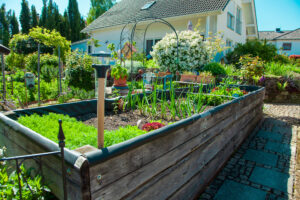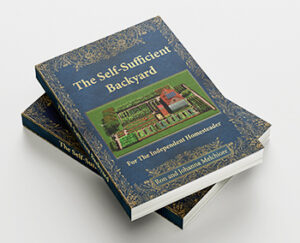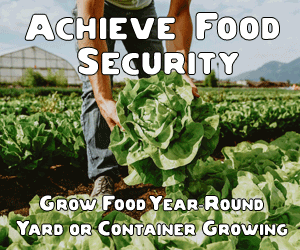Why Backyard Homestead?
Backyard homesteading is a way to be more self-sufficient, reduce environmental impact, and create a connection to the land. It can also be an opportunity for people to learn new skills, engage in physical activity, and become more involved in their community. Backyard homesteading can be scaled to fit almost anyone’s yard. I’ve even seen people with nothing but a patio make very productive container gardens!

Benefits of Backyard Homesteading
The benefits of backyard homesteading can include improved food security, increased self-sufficiency, and a connection to the land. Additionally, growing your own food can provide fresh and organic produce, help reduce grocery bills, and even be an opportunity to make some extra money by selling or bartering with others.
Ways to Backyard Homestead in a Small Yard
For those with limited outdoor space, there are still plenty of options for backyard homesteading. Depending on the size of the yard, it may be possible to successfully grow and harvest a variety of vegetables, herbs, fruit, and other crops. Additionally, there are several resources available for those interested in learning how to create small-scale gardens, such as container gardening and raised bed gardening. Composting can also be done on a smaller scale, such as a kitchen compost bin or vermicomposting. Beekeeping can also be done on a small scale with the use of Langstroth hives or top bar hives. Other ways to make the most of a small backyard homestead include water catchment systems, such as rain barrels, and the use of livestock like chickens, ducks, or goats. With a bit of creativity and planning, it’s possible to create a successful and sustainable homestead in a small backyard. Of course the bigger your yard the more you can do, but anyone with any size yard can add elements of backyard homesteading. A good resource for more info is The Self-Sufficient Backyard

Full disclosure this is an affiliate link but I like this series of books.
Re-cap list for ways to backyard homestead:
- Create a garden
- use raised beds or containers to grow what you can
- compost
- set up vermicomposting
- rain barrel water catchment you can then use on garden
- backyard chickens, rabbits or even goats if allowed
- partial of total solar power if you can afford it(you can get rebates)
- Consider geothermal
Livestock Options in the Small Backyard Homestead
For those interested in backyard livestock, there are a variety of options depending on the size of the yard available. Many small-scale livestock operations can be done in a backyard, such as raising chickens for eggs and meat, ducks for eggs or meat, goats for milk and cheese, rabbits for meat. It’s important to research the local regulations and ordinances before planning a backyard livestock operation. Some locations are fine with backyard chickens but not roosters because of the noise for instance. Additionally, it’s crucial to select the right breed of animal for the space and climate, as well as determine how much food and water your animals will need. Also, don’t forget to consider things like medical care, who will take care of your animals if you are away, and the degree of physical labor to care for the animals you have. With proper planning and care, it’s possible to have a successful small-scale livestock operation in the backyard.
List of possible livestock options for a backyard homestead:
- chickens(probably best not to have a rooster)
- ducks(need water, lots of water, very messy)
- rabbits
- quail
- small goat breeds ( must have two as they are herd animals)
Housing for Various Livestock in Small Backyard Homesteads
When housing livestock in a backyard, it’s important to create the right type of shelter for each animal. For chickens and ducks, coops are necessary to keep the birds safe from predators. For rabbits and goats, hutch-style shelters are ideal. Additionally, for all animals, it’s important to make sure that the shelter is properly insulated for cold weather and ventilated for hot weather. Lastly, there should be enough space for the animals to move around and have a comfortable living environment. With the right type of shelter, maintaining successful livestock is possible in a small backyard homestead. Of all these quail take up the least space.
Maintaining a Vegetable Garden in the Small Backyard Homestead
Growing and maintaining a productive vegetable garden is also possible in a small backyard homestead. It’s important to plan out the garden before planting, taking into account the space available and the amount of sunlight needed for each vegetable. Additionally, many vegetables need to be rotated each year and soil should be amended regularly to ensure proper nutrition for the plants. With good planning and care, it’s possible to have a thriving garden in a small backyard.
Some of the best vegetables to grow in small backyard gardens include tomatoes, carrots, snap peas, peppers, lettuce, strawberries, spinach and zucchini. These vegetables are relatively easy to grow and thrive in most climates, making them great options for a small backyard homestead. Additionally, these vegetables are packed with vitamins and minerals, so growing them at home can ensure that you have access to fresh, nutrient-rich produce.
The “dirty dozen” is a term used to refer to certain vegetables that are known to contain higher levels of chemical residue. These vegetables are traditionally grown with the use of pesticides and other chemicals, posing a higher risk to human health when consumed. The “dirty dozen” includes apples, celery, strawberries, spinach, nectarines, grapes, bell peppers, potatoes, cherries, and imported snap peas. Many of these can be grown in a backyard garden. If you have room plant, an apple or cherry tree. You will need two as they require pollinators but dwarf fruit trees abound now. Whenever possible, if you can’t grow your own, it is best to purchase organic versions of these vegetables to reduce your intake of potentially harmful chemicals.
Animal and Vegetable Waste Management
Proper waste management is essential for any backyard homestead, both for animal and vegetable waste. Animal waste needs to be managed properly to help keep the environment clean and healthy. For example, droppings can either be composted or buried to avoid disease and contamination. Additionally, vegetable waste should be composted as well to provide nutrition for the soil and help create a more sustainable environment. With the right waste management practices, backyard homesteaders can help protect the environment and maintain a successful homestead.
For more on composting check here.
Problems and Issues
Backyard homesteading can be challenging, time-consuming, and expensive. It also requires knowledge of plants, animals, and the environment. Additionally, it can require complex problem-solving to work through any issues that may arise. Lastly, zoning and permitting regulations can be an issue in some areas, so it’s important to make sure your homesteading activities are compliant.
Conclusion
Overall, backyard homesteading can be a rewarding experience that provides several benefits. However, it is important to do your research and be aware of the potential issues and challenges before embarking on a homesteading journey.
However, it is important to keep in mind that backyard homesteading can be labor-intensive and may require a consistent effort to see results. It is also important to have realistic expectations and set achievable goals to get the most out of your homesteading experience. With these considerations in mind, you can ensure that your backyard homestead journey will be successful. Good luck!

